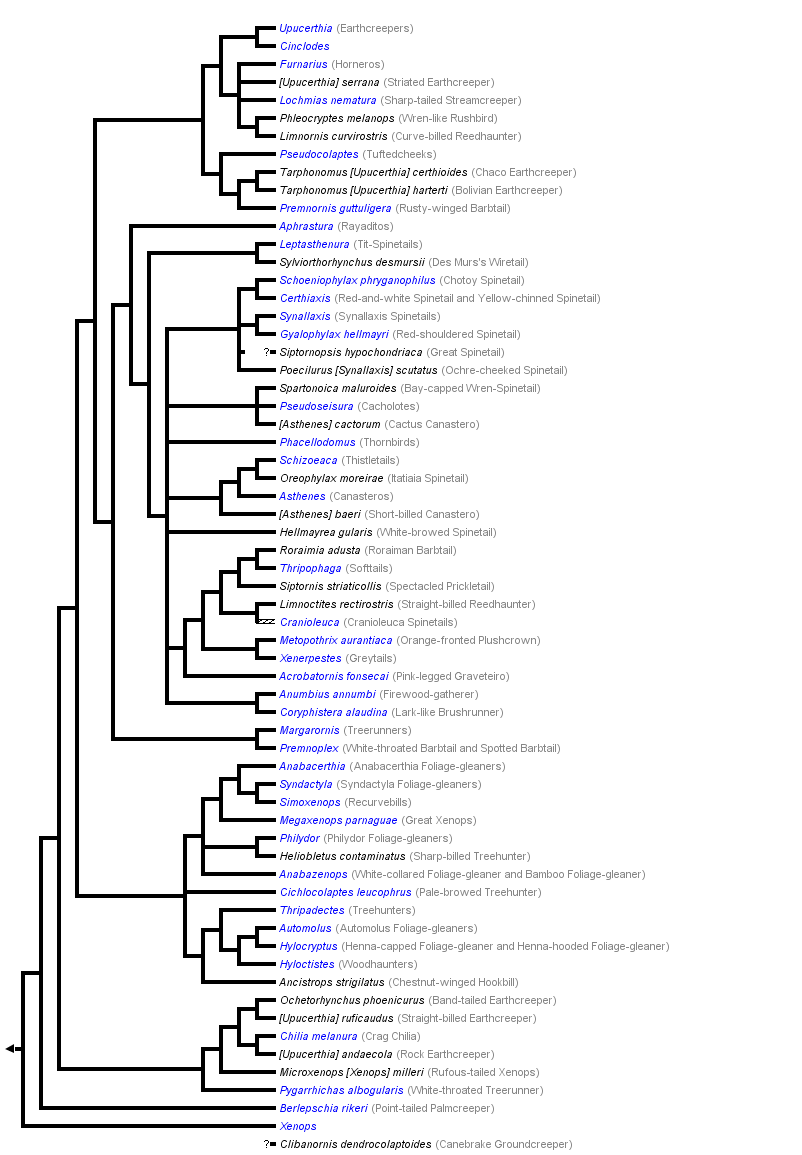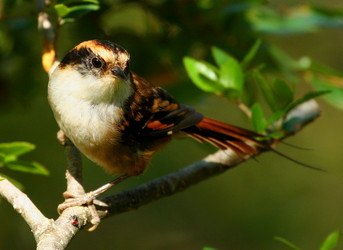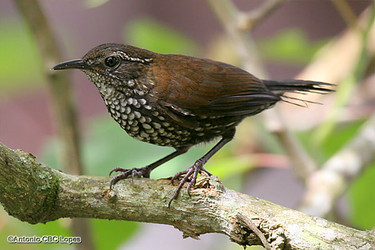Furnariidae
Ovenbirds
John Harshman


This tree diagram shows the relationships between several groups of organisms.
The root of the current tree connects the organisms featured in this tree to their containing group and the rest of the Tree of Life. The basal branching point in the tree represents the ancestor of the other groups in the tree. This ancestor diversified over time into several descendent subgroups, which are represented as internal nodes and terminal taxa to the right.

You can click on the root to travel down the Tree of Life all the way to the root of all Life, and you can click on the names of descendent subgroups to travel up the Tree of Life all the way to individual species.
For more information on ToL tree formatting, please see Interpreting the Tree or Classification. To learn more about phylogenetic trees, please visit our Phylogenetic Biology pages.
close boxRelationships after Chesser et al. 2007, Fjeldså et al. 2007, Irestedt et al. 2006, Moyle et al. 2009.
Discussion of Phylogenetic Relationships
The traditional family Furnariidae (ovenbirds) is not monophyletic; current research suggests that only three genera, here given their own family Scleruridae, must be removed to make it so. The genus Xenops has been argued to be the sister group of the woodcreepers (Irestedt et al. 2002, 2006), but more recent analyses (Moyle et al. 2009) place it within ovenbirds.Within Furnariidae, several genera are not monophyletic. Upucerthia (earthcreepers) is split into five parts. Cranioleuca and Asthenes too are not monophyletic, but not enough species have been sampled to make relationships clear. Further study may reveal more non-monophyletic genera. The genus name always goes with the type species, and other parts of the polyphyletic genera will need other names eventually. Some of these have already been proposed, e.g. Tarphonomus for two species formerly placed in Upucerthia. Unfortunately, the type species of several polyphyletic genera, Asthenes among them, have not yet been sampled, and so I am forced to guess which fragment of the genus retains its name. I have adopted a convention to deal with species that have new genus names, or that now need them: the old genus name appears in brackets, after the new genus name if there is one, alone if there isn't.
References
Areta, J. I. 2007. Behavior and phylogenetic position of Premnoplex barbtails (Furnariidae). Condor 109(2):399-407.
Chesser, R. T. 2004. Molecular systematics of New World suboscine birds. Molecular Phylogenetics and Evolution 32:11-24.
Chesser, R. T., F. K. Barker, and R. T. Brumfield. 2007. Four-fold polyphyly of the genus formerly known as Upucerthia, with notes on the systematics and evolution of the avian subfamily Furnariinae. Molecular Phylogenetics and Evolution 44(3):1320-1332.
Fjeldså, J., M. Irestedt, and P. G. P. Ericson. 2005. Molecular data reveal some major adaptational shifts in the early evolution of the most diverse avian family, the Furnariidae. Journal of Ornithology 146:1–13.
Fjeldså, J., M. Irestedt, K. A. Jønsson, J. I. Ohlson, and P. G. P. Ericson. 2007. Phylogeny of the ovenbird genus Upucerthia: a case of independent adaptations for terrestrial life. Zoologica scripta 36(2):133-141.
Fjeldså, J. and N. Krabbe. 1990. Birds of the High Andes. Zoology Museum, University of Copenhagen, Denmark.
Gill, F. and M. Wright. 2006. Birds of the World: Recommended English Names. Princeton NJ: Princeton University Press.
Gonzalez, J. and M. Wink. 2008. Phylogenetic position of the monotypic Des Murs' Wiretail (Sylviorthorhynchus desmursii, Aves: Furnariidae) based on mitochondrial and nuclear DNA. J. Ornithol. 149:393-398.
Hilty, S. 2003. A guide to the birds of Venezuela. Princeton University Press, Princeton, NJ.
Irestedt, M., J. Fjeldså, and P. G. P. Ericson. 2006. Evolution of the ovenbird-woodcreeper assemblage (Aves: Furnariidae) — major shifts in nest architecture and adaptive radiation. Journal of Avian Biology 37:261–272.
Irestedt, M., J. Fjeldså, U. S. Johansson, and P. G. P. Ericson. 2002. Systematic relationships and biogeography of the tracheophone suboscines (Aves: Passeriformes). Molecular Phylogenetics and Evolution 23:499–512.
Moyle, R. G., R. T. Chesser, R. T. Brumfield, J. G. Tello, D. J. Marchese, and J. Cracraft. 2009. Phylogeny and phylogenetic classification of the antbirds, ovenbirds, woodcreepers, and allies (Aves: Passeriformes: infraorder Furnariides. Cladistics 25:386-405.
Olson, S. L., M. Irestedt, P. G. P. Ericson, and J. Fjeldså. 2005. Independent evolution of two Darwinian marsh-swelling ovenbirds (Furnariidae: Limnornis, Limnoctites). Ornitología Neotropical 16:347–359.
Remsen, J. V. 2003. Family Furnariidae (Ovenbirds). Pages 162–357 in Handbook of the Birds of the World. Vol. 8: Broadbills to Tapaculos. J. del Hoyo, A. Elliot, and D. Christie, eds. BirdLife International and Lynx Editions, Cambridge, UK and Barcelona.
Rudge, D. W. and R. J. Raikow. 1992. Structure, function, and variation in the hindlimb muscles of the Margarornis assemblage (Aves: Passeriformes: Furnariidae). Annals of the Carnegie Museum 61:207–237.
Rudge, D. W. and R. J. Raikow. 1992. The phylogenetic relationships of the Margarornis assemblage (Furnariidae). Condor 94:760–766.
Sick, H. 1993. Birds in Brazil. A Natural History. Princeton University Press, Princeton, New Jersey.
Skutch, A. F. 1996. Antbirds and Ovenbirds. University of Texas Press, Austin, TX.
Vaurie, C. 1980. Taxonomy and geographical distribution of the Furnariidae (Aves, Passeriformes). Bulletin of the American Museum of Natural History 166:1–357.
Zyskowski, K. and R. O. Prum. 1999. Phylogenetic analysis of the nest architecture of neotropical ovenbirds (Furnariidae). Auk 116:891–911.
Title Illustrations

| Scientific Name | Aphrastura spinicauda |
|---|---|
| Location | Petrohué, Chile |
| Specimen Condition | Live Specimen |
| Source | Rayadito (Aphrastura spinicauda) |
| Source Collection | Flickr |
| Image Use |
 This media file is licensed under the Creative Commons Attribution-NonCommercial-NoDerivs License - Version 2.0. This media file is licensed under the Creative Commons Attribution-NonCommercial-NoDerivs License - Version 2.0.
|
| Copyright | © 2007 Pablo Caceres Contreras |
| Scientific Name | Lochmias nematura |
|---|---|
| Location | Petrópolis, Brasil |
| Specimen Condition | Live Specimen |
| Source | João-porca |
| Source Collection | Flickr |
| Image Use |
 This media file is licensed under the Creative Commons Attribution-NonCommercial-NoDerivs License - Version 2.0. This media file is licensed under the Creative Commons Attribution-NonCommercial-NoDerivs License - Version 2.0.
|
| Copyright | © 2006 Antonio CBC Lopes |
About This Page
Correspondence regarding this page should be directed to John Harshman at
Page copyright © 2009
 Page: Tree of Life
Furnariidae. Ovenbirds.
Authored by
John Harshman.
The TEXT of this page is licensed under the
Creative Commons Attribution-NonCommercial License - Version 3.0. Note that images and other media
featured on this page are each governed by their own license, and they may or may not be available
for reuse. Click on an image or a media link to access the media data window, which provides the
relevant licensing information. For the general terms and conditions of ToL material reuse and
redistribution, please see the Tree of Life Copyright
Policies.
Page: Tree of Life
Furnariidae. Ovenbirds.
Authored by
John Harshman.
The TEXT of this page is licensed under the
Creative Commons Attribution-NonCommercial License - Version 3.0. Note that images and other media
featured on this page are each governed by their own license, and they may or may not be available
for reuse. Click on an image or a media link to access the media data window, which provides the
relevant licensing information. For the general terms and conditions of ToL material reuse and
redistribution, please see the Tree of Life Copyright
Policies.
- First online 05 December 2007
- Content changed 22 August 2009
Citing this page:
Harshman, John. 2009. Furnariidae. Ovenbirds. Version 22 August 2009 (under construction). http://tolweb.org/Furnariidae/67993/2009.08.22 in The Tree of Life Web Project, http://tolweb.org/










 Go to quick links
Go to quick search
Go to navigation for this section of the ToL site
Go to detailed links for the ToL site
Go to quick links
Go to quick search
Go to navigation for this section of the ToL site
Go to detailed links for the ToL site